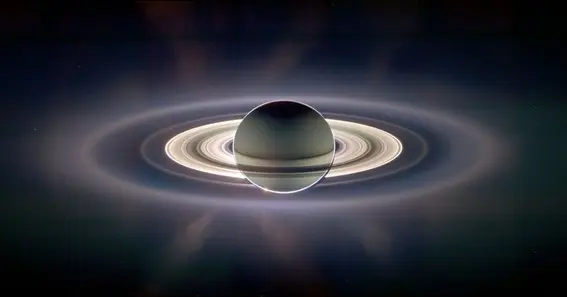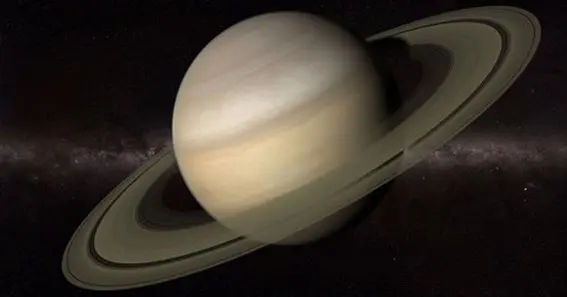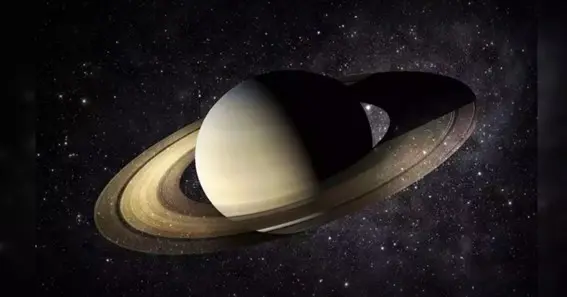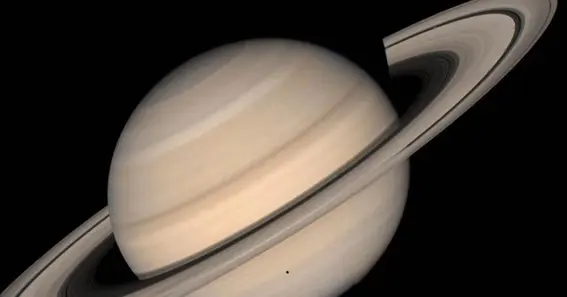What color is Saturn? Saturn’s color is a mix of yellow and brown. It stands out in pictures of the planets in our solar system. The strange planet looks like a ringed odd pearl. Let’s keep reading this guide to know about Saturn’s color.
What Color Is Saturn?
The color of Saturn is a mix of yellow and brown. Saturn’s outer atmosphere is mainly hydrogen and helium. Its atmosphere is yellowish-brown with orange hints due to minor concentrations of ammonia, phosphine, water vapor, and hydrocarbons. Hydrogen in the atmosphere gives its clouds a deep red color. However, the ammonia clouds cover up this red color, making them the top layer that covers the whole world.
Saturn typically appears pale gold or yellowish-brown due to its cloud layers made mostly of hydrogen and helium, with trace gases giving it its subtle hue.
What Does Saturn Consist Of?

The gas giant is interesting because it mostly has the same parts as the Sun. However, the planet doesn’t have enough mass to fuse and become a star.
Formation Of Saturn
Earth, like all the other planets in the Solar System, came from the solar nebula. Gravity pulled gas and dust together about four and a half billion years ago to make Saturn. The planet moved into place about 4 billion years ago, making it the sixth planet from the Sun.
Saturn’s Shape
This gas giant planet is mostly hydrogen and helium. Its core is thick metal. The liquid metallic hydrogen and a layer of liquid hydrogen surround it. The liquid hydrogen slowly turns into gas. The layer of gas that covers the outside of Saturn is one thousand kilometers thick.
Saturn Surface
If you tried to walk on Saturn’s surface, you would sink through its outer part, which is very hot and pressurized. Gases move around on the planet’s surface.
Saturn’s Orbit
The ringed planet’s path is easy to understand and predict. As Earth goes around the Sun once a year, it passes close to Saturn for about two months. This always happens at a time when all three bodies are lined up in a straight line, with Earth in the middle. This is called opposition.
After that, we move on, go around the Sun again, and get closer to Saturn. Saturn, on the other hand, moves very slowly. In its 29-1/2-year circle, Saturn moves forward just a little, which means that our meeting is about two weeks later every year.
What Makes The Planets Their Colour?

If someone asks you what color Saturn is, you should know what makes planets different and what makes Saturn unique in this way. It is the sixth farthest from the Sun, and the solar system is the second largest planet. With its many rings and unique colors, Saturn sticks out from the other planets. We know that the visual system sees colors based on how much light an item absorbs and reflects. The atmosphere also affects how planets see colors because it soaks up and spreads out the Sun’s rays on their way to the surface.
From space, the Earth looks blue, green, and dark because of its woods, seas, and soil. The red color of Mars comes from the iron oxide particles that cover its surface. In the same way, Saturn’s color relies on the things that make it up, its atmosphere, and how much sunlight it gets.
Several More Facts About Saturn:

Saturn is the second-biggest planet in the solar system. It is big enough to hold more than nine Earths. Saturn is cold on the outside but hot on the inside. Its center is about 21,150°F, which is how hot it is. Saturn is -280°F cold most of the time. Venus has winds that go as fast as eleven thousand miles per hour.
Over the moon? Right now, 2019: We know that Saturn has 82 moons (and growing!). It’s just ahead of Jupiter, which has 79 moons. The largest moon of Saturn is Titan. Saturn is the least dense planet because it is mostly gas. It would float in a very large pool. Each of Saturn’s unconnected rings contains billions of bits of ice, dust, and rock, from a grain of salt to a home.
Conclusion
From a scientific point of view, Saturn is both beautiful and strange because its colour changes constantly due to many factors. Its strong rings also add to the planet’s mystery. This is why Saturn is known as the “pearl of the solar system.”
FAQ
What should you know about Saturn?
At its widest point, Saturn is about 74,897 miles (120,500 kilometres) across, making it nine times bigger than Earth.
What makes Saturn unique?
Saturn is unique among planets with its brilliant ice rings.
How does Saturn affect love?
Strong Saturn can encourage careful and responsible love, promoting secure and long-lasting relationships.
What does everyone know about Saturn?
It is the second-largest one and sixth planet from the Sun.
What is another name for Saturn?
This planet is known as “The Ringed Planet” because of its huge, glorious, and widespread ring system.
Check out this insightful post is-andrew-tate-muslim
Sources:
https://www.thesun.co.uk/tech/19506711/saturn-what-colour
https://starwalk.space/en/news/facts-about-saturn-explore-the-amazing-ringed-planet
https://orbitaltoday.com/2023/07/03/the-pearl-of-the-solar-system-what-is-saturns-colour-really










